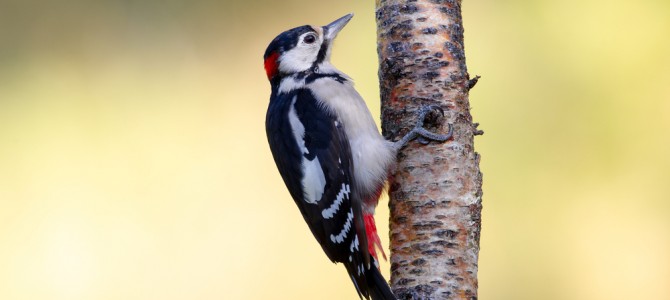The average woodpecker hits its beak against a tree at an estimated 15 miles an hour, 20 times per second, about 12,000 times a day. According to physicists, for the bird, that is an equivalent of coming to a complete stop every second from 26,000 miles per hour. This happens every day over the woodpecker’s lifespan. In g-force—the force exerted using mass, weight, acceleration, and gravity—a woodpecker can withstand 1,200 g. Yet the birds do not suffer any head injuries or brain trauma.
In comparison, the average National Football League hit has two players colliding between 100 to 150 g, often experiencing concussions that register when impact reaches 80 to 100 g. How then, is it possible that a tiny bird can withstand ten times the impact as a human, and why have researchers not devoted more research to the bird brain?
What Woodpeckers Have that We Don’t
A few physiological differences protect the woodpecker’s brain from trauma. First, and most importantly, the brain of the bird fills the space of the skull. Unlike the human brain, which is more like an eggshell with an egg yolk on the inside, the woodpecker brain cannot slosh around. This “slosh” is what doctors are beginning to study with increased frequency, looking for various ways during impact to fill (or cushion) the cerebral space inside so the brain doesn’t rattle around. Obviously, these most protective measures cannot be done with any kind of airbag, helmet, or sensor. The buffer must come from within the skull.
Another difference is the comparative size of the human and bird brain. Because the woodpecker brain is so small, its surface area to weight ratio distributes the force of impact over the entire region. This is not the case for human brains, which take hits in specific areas and experience blunt trauma. We also experience trauma from different angles and while in motion and rotation, whereas woodpeckers hit their targets in a straight, consistent line. With each hit, the entire body of the bird knows what motion will take place and which muscles will be used, and avoids any rotation that would cause strain.
A specific bone exists in both birds and humans that serves very significant purposes. The hyoid bone in the human body is located near the middle of the neck. However, in the woodpecker this bone warps all the way around the actual skull. When the bird pecks, the bone actually acts like a seatbelt for the brain, minimizing impact.
The Prime Natural Shock Absorber
Since woodpeckers are possibly the world’s best shock absorber, it’s surprising they and their amazing evolutionary characteristics have not been a significant scientific focus for decades. With more than 180 species of woodpeckers located all around the globe, the potential is unlimited. As the world continues to better understand the brain and all the ways that it controls every aspect of the human body and experience, any gains in scientific literature on protecting us from brain injury are invaluable.
As athletes get bigger, faster, and stronger, concussions will continue to happen regularly. But the negative impact they have on the brain may be mitigated through better research and prevention. Perhaps in the near future we will hear sport broadcasters talk about g-force or fluctuations in cerebral fluid as naturally on air as they do now when discussing knee injuries or broken bones.








